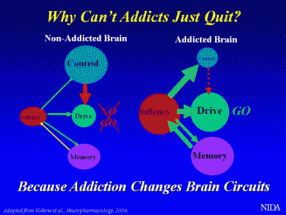NatCon15: What dopamine tells us about opioid addiction

Addiction Treatment Articles
12 Step Recovery Articles
Methadone Maintenance
Opioid Addiction Treatment
Addiction Research Articles
Addiction Neurobiology Articles
Overview
Originally Published: 04/20/2015
Post Date: 04/23/2015
Source Publication: Click here
by Julia Brown
Summary/Abstract
What dopamine tells us about opioid addiction presented by Corey Waller, at NatCon 15 examines the treatment providers obligation to consider data, science and math should in determining treatment. .
Content
What Dopamine Tells Us About Opioid Addiction
Evidence suggesting greater importance of dopamine in human survival has experts advocating for medication-assisted therapy in opioid addiction treatment. According to Corey Waller, director, Spectrum Health Medical Group-Center for Integrative Medicine, dopamine is as necessary for survival as food and water.
“Without this chemical in the brain, we don’t have the capability to get out of bed,” he says, speaking at the National Council for Behavioral Health 2015 conference in Orlando. “We have the inability to move forward and be the humans we want to be.”
The normal, daily amount of dopamine the average brain produces is typically around 50 nanograms per deciliter—100 on an exceptionally good day—will skyrocket when substances like tobacco (450), marijuana (650) and heroin (975) are introduced, he explains. In fact, it can reach a whopping 1,100 nanograms per deciliter under the effects of methamphetamine. “That’s instantly 10 times what the brain is supposed to be able to take,” he says.
The science behind cravings
As a long-term result of substance use, the body begins to produce less dopamine. Wallen says the science behind these reduced levels can be compared to the cravings of individuals on the verge of starvation and dehydration. By monitoring people with no fluid intake for three days in addition to those with no food intake for five days in functional MRIs using sensory stimuli, water cravings were measured to be the size of a baseball while food cravings were the size of a basketball. In comparison, he says, individuals 30 days sober were asked to describe the effects of their drug of choice, and their cravings were the size of a baseball field.
“[This] really helped me understand why the behaviors we see—why these very illogical things—happen, because it’s purely survival,” Wallen says. “The body is flipped over from thinking about logic and competing risks and risk adjustment.”
Raising dopamine levels
Wallen compares low dopamine levels to serotonin deficiency but with one major difference. Patients lacking serotonin can be prescribed SSRI and taught therapy to lock in cognitive behavioral therapy, mindfulness and coping skills. Buprenorphine and methadone both raise dopamine to normal levels of 40 to 60 nanograms per deciliter, but only 10% of patients are on the medications. In addition, low dopamine patients have difficulties with retaining information because long-term memory cannot settle in the hippocampus. They suffer from what he calls the “Charlie Brown effect”: hearing words but having extremely low treatment retention—less than 10%.
“What our hypothesis is, without the dopamine stabilizing the access in the brain that allows you to onboard memory—the therapy to change the behavior associated with the thought—it’s all wasted time,” Wallen says.
Why it's important in Medicaid treatment
Wallen breaks down addiction treatment into two groups: haves and have-nots. While the haves are individuals with social structures—a family that cares, children that are supportive and a job that can still be maintained—have-nots typically lack all of the above. The treatment question becomes how to motivate someone with no dopamine, housing or transportation.
“Pictures of unicorns and rainbows don’t fix it for these patients,” he says, adding that overcoming a chronic, neurological disease is not just about hope but rather allowing someone to [reach] certain desired points in their life.
When using an abstinence-based pathway, Wallen says the mortality rate for Medicaid patients is 10 times that of those who receive buprenorphine and methadone.
By the numbers
While physicians in recovery programs have 85% to 95% success rates with abstinence-based therapy, Wallen says factors that contribute to that success—family support, wrap-around engagement, extended in-patient recovery, mandatory urine testing and income—don't exist for all populations. At the end of the day, he says, addiction treatment is flawed in the variability of how individual providers treat the same patient despite evidence showing success rates of 70% to 75% when using a combination of medication-assisted treatment and behavioral therapy with Medicaid patients.
In comparison, diabetes patients can only lower hemoglobin A1c by 60% in a best-case scenario and only about 50% of hypertension patients can get better blood pressure with medication and exercise. Furthermore, he says, 12-step treatment is just 6% to 8% effective for Medicaid patients because it was structured for those with relatively sold social structures. "If it [were] a drug it would not pass the FDA," Wallen adds. "That's less than placebo."
Ultimately, he says, data, science and math should govern treatment.
“If we don’t move toward an evidence-based model of treatment in every aspect that we do, then we are failing our patients," Wallen says. "We are doing harm.”





